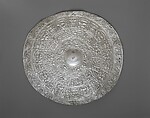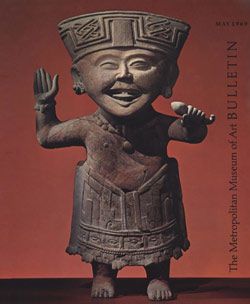Shield cover
Not on view
This disk, most likely a ceremonial shield cover (see 66.196.44), is one of at least eleven said to have been found in one or more burials on Peru’s north coast. All eleven share a similar composition of four concentric bands encircling a central convex boss. The relief decoration was achieved by working the sheet metal from the back, pressing the metal into a pliant material such as pitch. The designs were further enhanced by working the disk from the front using tracing tools to delineate forms. The eleven disks follow one of four distinct iconographic patterns featuring figures with crescent headdresses, marine animals, and mythological creatures (see also object number 66.196.44 in the Met's collection). The present disk is the sole example in which the outer register is defined by a wave-like, undulating band with what looks to be a tassel or cord motif in its interior. A shore bird is depicted in the interstices below the undulating band while a beaked mythological figure with raised arms appears in those above.
The second, and largest, register is composed of alternating anthropomorphic and zoomorphic forms. The zoomorphic forms appear to be a creature shown in profile and wearing a crescent headdress, thought to be a symbol of rank or divinity. An eel or snake emerges from the creature’s mouth, and a serpent-like form from the crown of the head, although it is possible the creature is simply biting into the body of an undulating, double-headed snake. The lower portion of the creature’s body is tripartite with a single, central, footed leg symmetrically flanked by additional open-mouthed, teeth-baring profile zoomorphic heads that flare out and down from the body. The anthropomorphic figure, also wearing a crescent headdress, holds a staff in either hand. The staves are probably plant forms, complete with roots and what appear to be ears of maize. A bicephalic snake form, perhaps a representation of a type of ornamental regalia, separates the head from the body.
The third band features a stepped-fret pattern, unusual in the corpus of Chimú silver disks. The fret forms are filled with tiny birds, monkeys, and mythological creatures. The innermost band consists of a ring of shore birds wearing crescent headdresses and grasping small unidentified, though somewhat lizard-like, creatures. This band displays greater variation in size between the motifs, as if the silversmith who created it had difficulty spacing the birds in the composition. Similarly, birds wearing crescent headdresses are depicted in the architectural reliefs at Chan Chan, the capital of the Chimú Empire, now an archaeological site near the modern city of Trujillo, Peru.
The rim of this disk was slightly folded over in two places, apparently in ancient times, giving the disk a slightly oval shape. After the edges were thus folded, five pairs of perforations plus a single perforation were made close to the edge of the disk. This thin silver disk was then likely lashed to a cane backing or frame to create a spectacular component of a warrior’s armor.
Joanne Pillsbury
Andrall E. Pearson Curator, Arts of the Ancient Americas, 2018
Published
Art of Oceania, Africa, and the Americas from the Museum of Primitive Art. New York: The Metropolitan Museum of Art, 1969, 471.
King, Heidi, Luis Jaime Castillo Butters, and Paloma Carcedo de Mufarech. Rain of the Moon: Silver in Ancient Peru. New York, New Haven and London: The Metropolitan Museum of Art, 2000, 15d, 44-5.
Further Reading
Boone, Elizabeth Hill, ed., Andean Art at Dumbarton Oaks. Washington, D.C.: Dumbarton Oaks Research Library and Collection, 1996, pp. 218-222.
Donnan, Christopher B., Moche Tombs at Dos Cabezas. Los Angeles, CA: Cotsen Institute of Archaeology at UCLA, 2007.
Pillsbury, Joanne. "Luxury Arts and the Lords of Chimor," in Latin American Collections: Essays in Honor of Ted J.J. Leyenaar, Dorus Kop Jansen and Edward de Bock, eds., pp. 67-81. Leiden: Ed. Tetl, 2003
Due to rights restrictions, this image cannot be enlarged, viewed at full screen, or downloaded.


